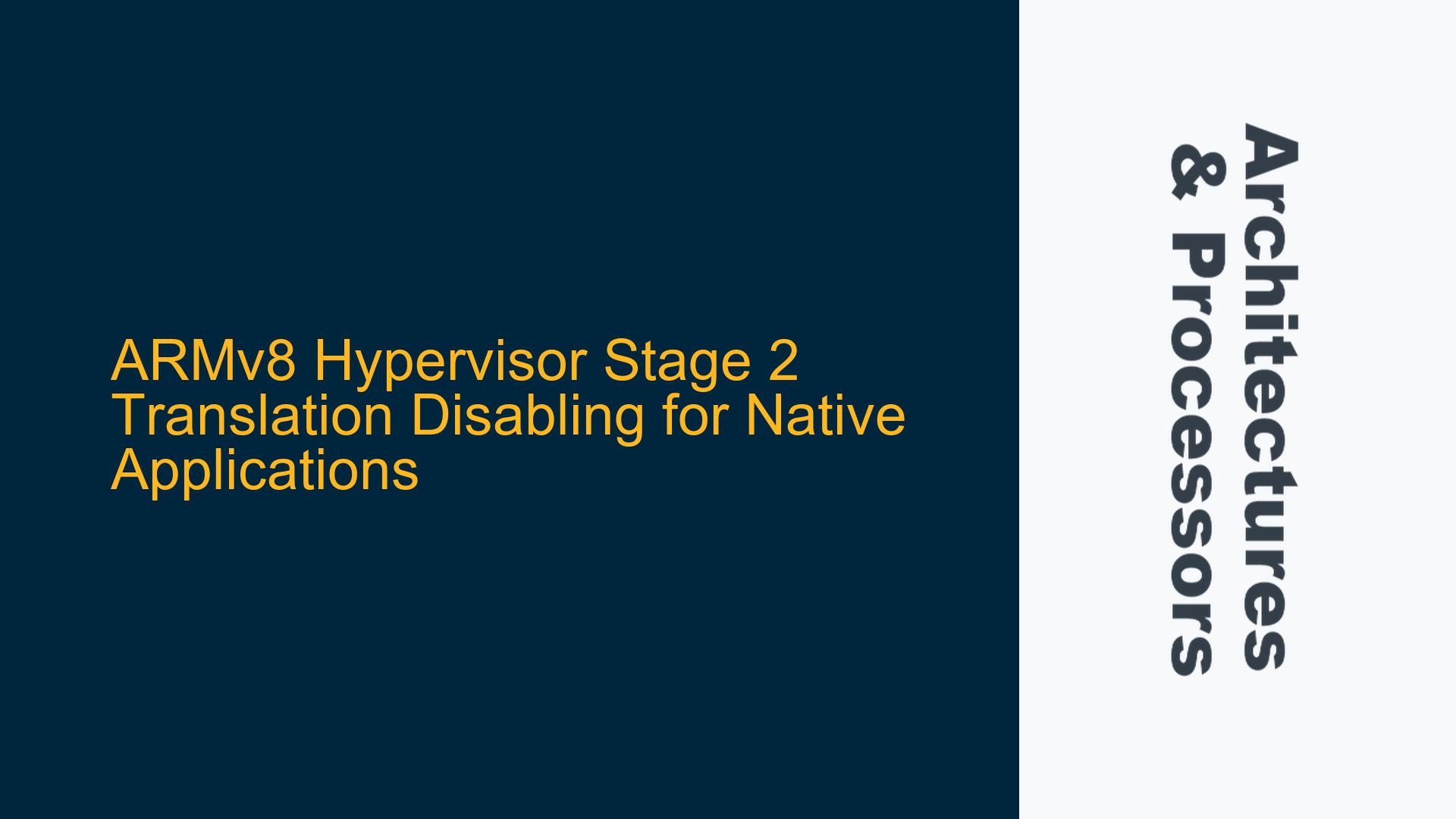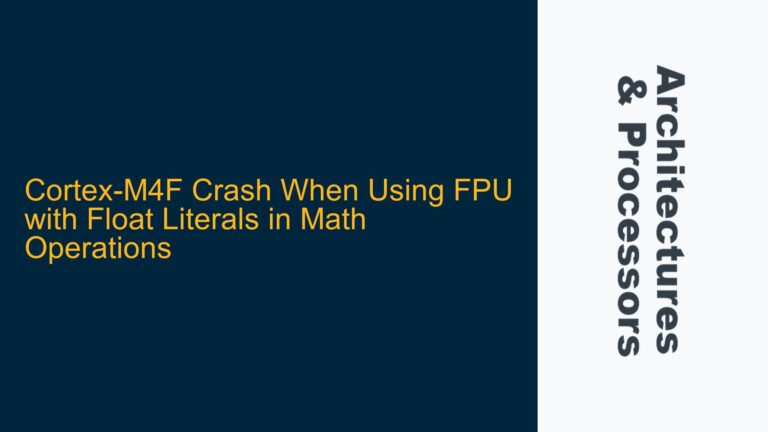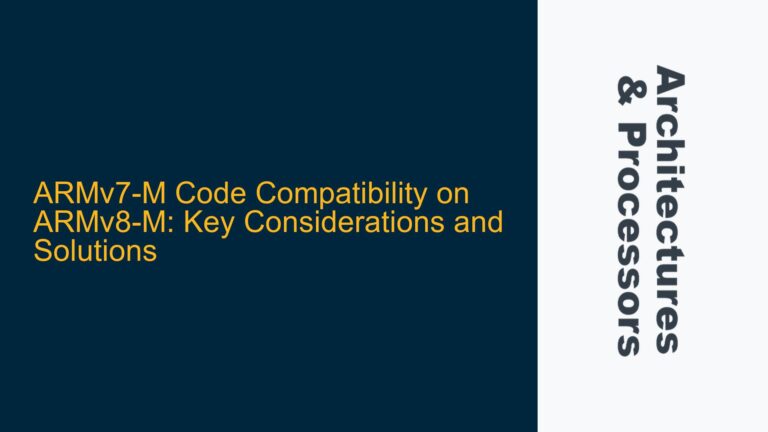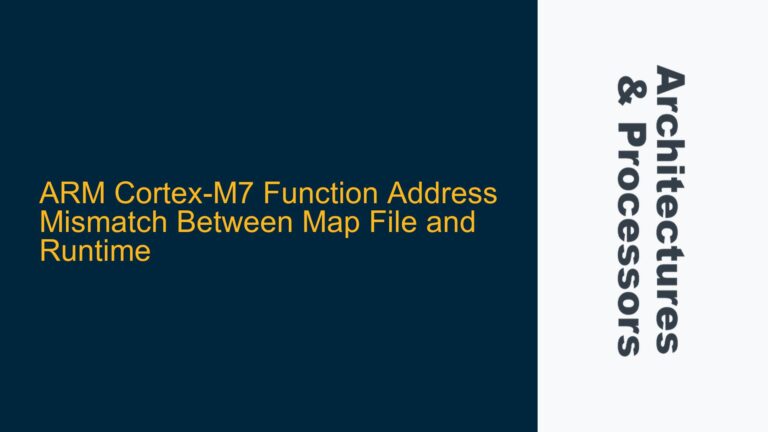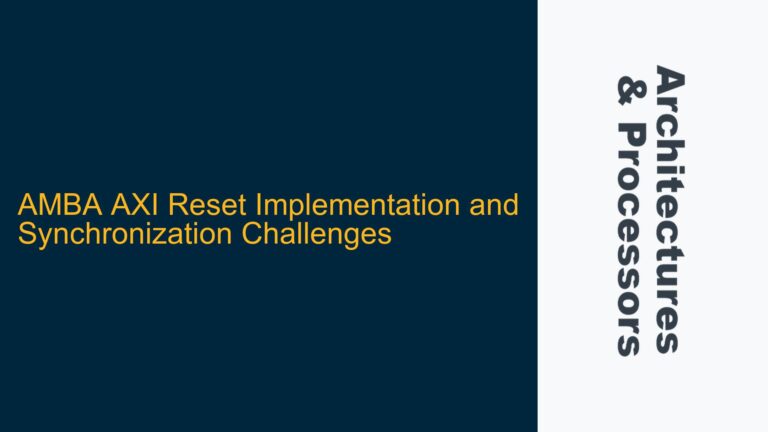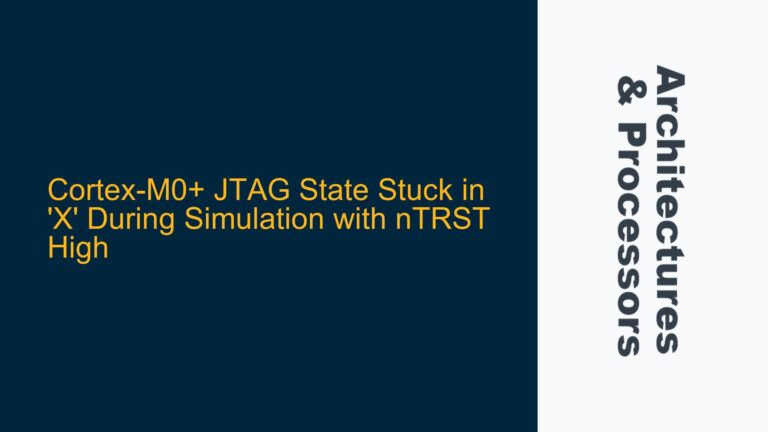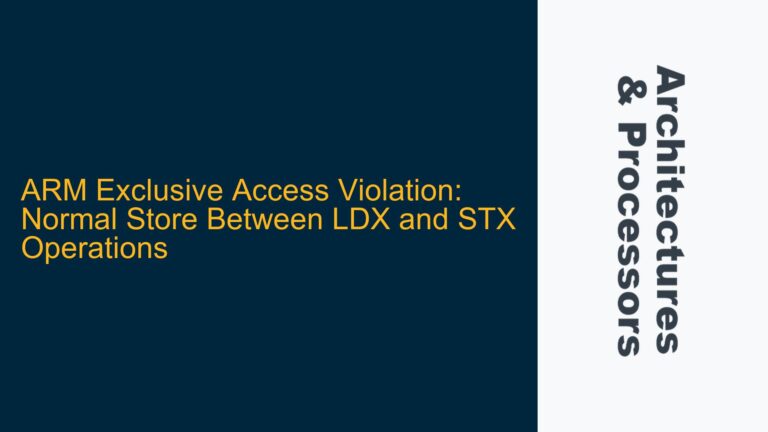ARMv8 Virtualization and Address Translation Challenges in Mixed Environments
In ARMv8-based systems, virtualization is a critical feature that enables the coexistence of virtual machines (VMs) and native applications within the same hardware environment. The ARMv8 architecture provides a two-stage address translation mechanism: Stage 1 (S1) translation, which is managed by the guest operating system (OS) running in a VM, and Stage 2 (S2) translation, which is managed by the hypervisor to provide isolation between VMs and the host. However, in certain scenarios, native applications may require address spaces larger than what the intermediate physical address (IPA) size allows when S2 translation is enabled. This creates a challenge when attempting to run such native applications alongside VMs in a virtualized environment.
The core issue arises when a native application, running directly under the hypervisor at EL0, requires a 48-bit virtual address space, while the physical address space is limited to 44 bits. The S2 translation, which is typically used to isolate VMs, restricts the addressable memory to the IPA size, which in this case is 44 bits. This limitation prevents the native application from utilizing the full 48-bit virtual address space it requires. The proposed solution involves disabling S2 translation for the native application while keeping it enabled for VMs, effectively allowing the native application to bypass the IPA limitation and use a larger virtual address space.
However, this approach introduces several complexities, particularly in systems without Virtualization Host Extensions (VHE). VHE simplifies the management of mixed environments by allowing the hypervisor to run at EL2 while hosting VMs and native applications. Without VHE, the hypervisor must carefully manage the transition between S2-enabled and S2-disabled states, ensuring that the isolation and security of VMs are not compromised.
Memory Management and Translation Regime Configuration Without VHE
The absence of VHE in ARMv8.0-A systems complicates the management of translation regimes. In a typical VHE-enabled system, the hypervisor can run at EL2 and manage both S1 and S2 translations seamlessly. However, in a non-VHE system, the hypervisor must switch between EL1 and EL2 to manage the translation regimes for native applications and VMs, respectively. This switching introduces overhead and potential security risks if not handled correctly.
One possible cause of the issue is the improper configuration of the Hypervisor Configuration Register (HCR_EL2). The HCR_EL2 register controls various aspects of the hypervisor’s behavior, including the enabling and disabling of S2 translation. Specifically, the HCR_EL2.TGE (Trap General Exceptions) bit can be used to disable entry to EL1, allowing the hypervisor to host a native application at EL0 without S2 translation. However, this approach requires careful consideration of the implications, as setting HCR_EL2.TGE affects the entire system’s behavior, not just the translation regime.
Another potential cause is the misconfiguration of the Virtual Machine Identifier (VMID). Each VM in the system is assigned a unique VMID, which is used by the hypervisor to manage the S2 translation tables. When running a native application without S2 translation, it is still necessary to assign it a unique VMID to maintain isolation from VMs. Failure to do so could result in memory access violations or security breaches.
Additionally, the timing of S2 translation enabling and disabling is critical. If S2 translation is disabled too early or re-enabled too late, the native application may inadvertently access memory regions that are reserved for VMs, leading to data corruption or security vulnerabilities. Conversely, if S2 translation is enabled too early or disabled too late, the native application may be unable to access its required memory regions, resulting in application crashes or performance degradation.
Implementing Secure and Efficient Translation Regime Switching
To address the challenges of running native applications with larger address spaces alongside VMs in a non-VHE ARMv8 system, a systematic approach to managing the translation regimes is required. The following steps outline a potential solution:
-
Hypervisor Configuration and VMID Assignment: Before running the native application, the hypervisor must ensure that the HCR_EL2 register is configured correctly. Specifically, the HCR_EL2.TGE bit should be set to disable entry to EL1, allowing the native application to run at EL0 without S2 translation. Additionally, the native application should be assigned a unique VMID to maintain isolation from VMs. This VMID should be distinct from those assigned to VMs and should be used consistently throughout the application’s execution.
-
S2 Translation Disabling and Re-enabling: The hypervisor must carefully manage the timing of S2 translation disabling and re-enabling. Before switching to the native application, the hypervisor should disable S2 translation by clearing the appropriate bits in the HCR_EL2 register. This ensures that the native application can access the full 48-bit virtual address space without being constrained by the 44-bit IPA size. Once the native application has completed its execution, the hypervisor should re-enable S2 translation by setting the appropriate bits in the HCR_EL2 register, ensuring that VMs remain isolated and secure.
-
Memory Barrier and Cache Management: When switching between S2-enabled and S2-disabled states, the hypervisor must ensure that all memory accesses are properly synchronized. This can be achieved by implementing data synchronization barriers (DSBs) and instruction synchronization barriers (ISBs) at the appropriate points in the code. Additionally, the hypervisor should invalidate the translation lookaside buffer (TLB) entries associated with the native application to prevent stale entries from causing memory access violations.
-
Security and Isolation Considerations: The hypervisor must ensure that the native application cannot access memory regions reserved for VMs, even when S2 translation is disabled. This can be achieved by carefully configuring the memory protection units (MPUs) and memory management units (MMUs) to enforce access controls. Additionally, the hypervisor should monitor the native application’s memory access patterns to detect and prevent any unauthorized access attempts.
-
Performance Optimization: The overhead associated with switching between S2-enabled and S2-disabled states can impact system performance. To mitigate this, the hypervisor should optimize the switching process by minimizing the number of register writes and memory barriers required. Additionally, the hypervisor should leverage hardware features such as the ARM Cortex-A series’ cache coherency mechanisms to reduce the performance impact of cache management operations.
By following these steps, the hypervisor can effectively manage the translation regimes for both native applications and VMs in a non-VHE ARMv8 system, ensuring that the native application can utilize the full 48-bit virtual address space while maintaining the isolation and security of VMs.
Detailed Implementation and Best Practices
To provide a more detailed understanding of the implementation, let’s delve into the specifics of each step:
Hypervisor Configuration and VMID Assignment
The hypervisor must first configure the HCR_EL2 register to disable entry to EL1 by setting the HCR_EL2.TGE bit. This ensures that the native application runs at EL0 without S2 translation. The following code snippet demonstrates how to configure HCR_EL2:
// Set HCR_EL2.TGE to disable entry to EL1
MOV x0, #(1 << 27) // TGE bit
MSR HCR_EL2, x0
Next, the hypervisor must assign a unique VMID to the native application. This VMID should be distinct from those assigned to VMs and should be used consistently throughout the application’s execution. The VMID can be assigned by writing to the Virtual Machine Identifier Register (VTTBR_EL2):
// Assign a unique VMID to the native application
MOV x0, #(UNIQUE_VMID << 16) // VMID in the upper 16 bits
MSR VTTBR_EL2, x0
S2 Translation Disabling and Re-enabling
The hypervisor must carefully manage the timing of S2 translation disabling and re-enabling. Before switching to the native application, the hypervisor should disable S2 translation by clearing the appropriate bits in the HCR_EL2 register:
// Disable S2 translation by clearing HCR_EL2.VM
MOV x0, #0
MSR HCR_EL2, x0
Once the native application has completed its execution, the hypervisor should re-enable S2 translation by setting the appropriate bits in the HCR_EL2 register:
// Re-enable S2 translation by setting HCR_EL2.VM
MOV x0, #(1 << 0) // VM bit
MSR HCR_EL2, x0
Memory Barrier and Cache Management
When switching between S2-enabled and S2-disabled states, the hypervisor must ensure that all memory accesses are properly synchronized. This can be achieved by implementing data synchronization barriers (DSBs) and instruction synchronization barriers (ISBs) at the appropriate points in the code:
// Synchronize memory accesses with DSB and ISB
DSB SY
ISB
Additionally, the hypervisor should invalidate the TLB entries associated with the native application to prevent stale entries from causing memory access violations:
// Invalidate TLB entries for the native application
TLBI VMALLE1
DSB SY
ISB
Security and Isolation Considerations
The hypervisor must ensure that the native application cannot access memory regions reserved for VMs, even when S2 translation is disabled. This can be achieved by carefully configuring the MPUs and MMUs to enforce access controls. The following table outlines the memory protection settings for the native application and VMs:
| Memory Region | Native Application Access | VM Access |
|---|---|---|
| VM Reserved | Denied | Allowed |
| Native App | Allowed | Denied |
Performance Optimization
To minimize the performance impact of switching between S2-enabled and S2-disabled states, the hypervisor should optimize the switching process by reducing the number of register writes and memory barriers required. Additionally, the hypervisor should leverage hardware features such as the ARM Cortex-A series’ cache coherency mechanisms to reduce the performance impact of cache management operations.
By following these detailed implementation steps and best practices, the hypervisor can effectively manage the translation regimes for both native applications and VMs in a non-VHE ARMv8 system, ensuring that the native application can utilize the full 48-bit virtual address space while maintaining the isolation and security of VMs.
